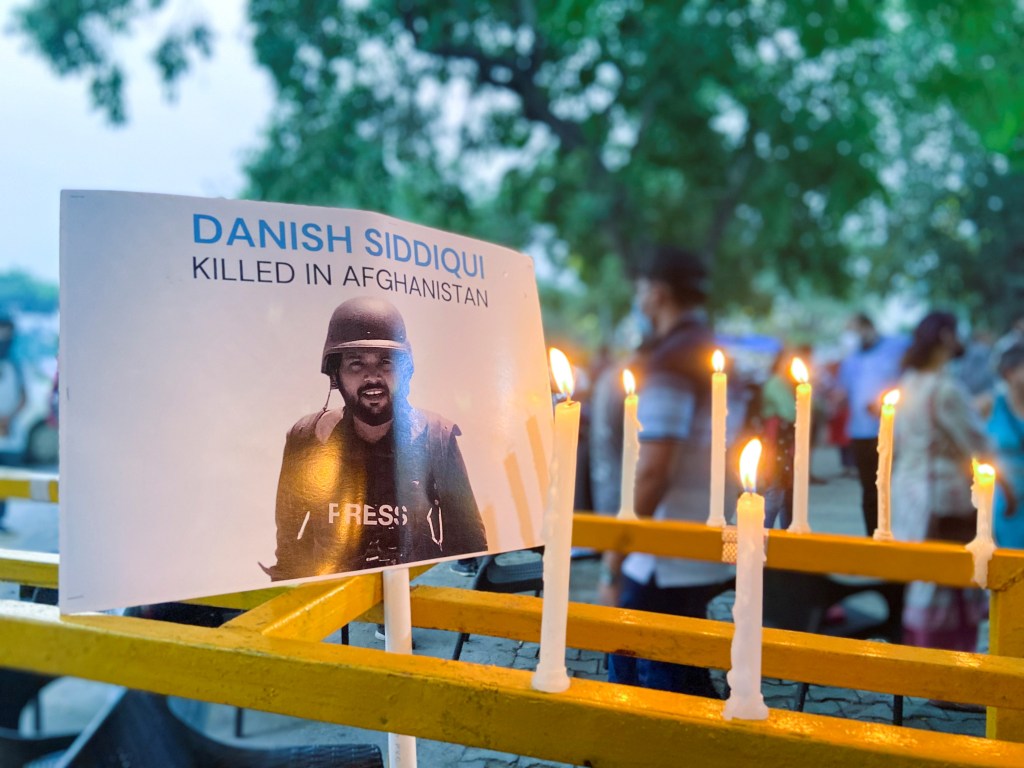By Jennifer Dunham/CPJ Deputy Editorial Director
Published January 19, 2022
At least 28 journalists were killed due to their work in 2021, with India and Mexico topping the list of countries with the most media worker deaths, according to the Committee to Protect Journalists’ final data for the year. Of the total – which has risen by four since the publication of CPJ’s December 9 report on attacks on the press – 22 were singled out for murder in retaliation for their reporting. Four more were killed while reporting from conflict zones, and two others were killed covering protests or street clashes that turned deadly.
CPJ is still investigating the deaths of 17 other journalists – including five from Mexico –to determine whether their killings were work-related.
While the overall total of journalist deaths dropped from 2020’s number of 32, the number of confirmed retaliatory murders remained roughly the same, suggesting that journalists continue to be seen as targets. The two countries with the highest number of murders – India and Mexico, each of which registered four confirmed murders – both feature on CPJ’s Global Impunity Index, which spotlights countries where members of the press are singled out for murder and the perpetrators go free.
At least two journalists were killed in Myanmar, amid the military junta’s brutal crackdown on the press that also saw at least 26 journalists imprisoned for their reporting as of December 1, 2021. The two deaths, both in December, represented CPJ’s highest yearly recorded tally for journalist killings in Myanmar since 1999, and the country emerged as the world’s second-worst jailer of journalists after China in CPJ’s 2021 prison census.
Other findings from CPJ’s research on journalist killings include:
- Political groups, such as anti-government parties or combatants, were the most frequently suspected killers of journalists in 2021, while politics was the most dangerous beat.
- Afghan television anchor Mina Khairi – who was killed in June in Kabul when unidentified attackers detonated an improvised explosive device attached to a van she was riding in – was the only female journalist confirmed to have been targeted for murder in 2021. Another reporter, Yemeni photojournalist Rasha Abdullah al-Harazi – who was pregnant at the time – was killed by a car bomb on November 9, 2021, but it’s believed that the attack was aimed at her husband, Mahmoud al-Atmi. Al-Atmi, also a journalist, was seriously injured in the explosion.
- The vast majority of killed journalists were locals covering the news in their home countries. Three foreign journalists were killed in 2021: Indian photojournalist Danish Siddiqui, who died in Afghanistan from injuries sustained while covering clashes between Afghan forces and the Taliban in July; and Spanish documentary film crew David Beriain and Roberto Fraile, who were kidnapped and killed in Burkina Faso in April.
- Lebanese journalist Lokman Slim – who was murdered in February – was the only confirmed killing in the Middle East and North Africa in 2021, a sharp decrease after record-high levels of journalist deaths in the region over the last decade.
Learn more about CPJ’s 2021 data on killed and imprisoned journalists from our interactive map and annual prison census.
Methodology
CPJ began compiling detailed records on all journalist deaths in 1992. CPJ staff members independently investigate and verify the circumstances behind each death. CPJ considers a case work-related only when its staff is reasonably certain that a journalist was killed in direct reprisal for his or her work; in combat-related crossfire; or while carrying out a dangerous assignment such as covering a protest that turns violent.
If the motives in a killing are unclear, but it is possible that a journalist died in relation to his or her work, CPJ classifies the case as “unconfirmed” and continues to investigate.
CPJ’s list does not include journalists who died of illness or were killed in car or plane accidents unless the crash was caused by hostile action. Other press organizations using different criteria cite different numbers of deaths.
CPJ’s database of journalists killed in 2021 includes capsule reports on each victim and filters for examining trends in the data. CPJ maintains a database of all journalists killed since 1992 and those who have gone missing or are imprisoned for their work.
[Editor’s note: Based on new information obtained by CPJ in 2022, we have reclassified the motive for the 2021 murder of Mexican journalist Alfredo Cardoso Echeverría as “confirmed.” The data in the first three paragraphs of this report has been updated to reflect this change. (See our FAQs for more on our data methodology.)]
Jennifer Dunham is CPJ’s deputy editorial director. Prior to joining CPJ, she was research director for Freedom House’s Freedom in the World and Freedom of the Press reports.
